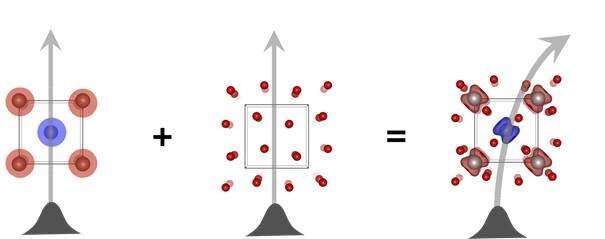
Sometimes combinations of different things produce effects that no one expects, such as when completely new properties appear that the two combined parts do not have on their own. Dr. Libor Šmejkal from Johannes Gutenberg University Mainz (JGU) found such an unexpected property: He combined antiferromagnetic substances with non-magnetic atoms and found that, contrary to the current doctrine, a Hall current occurs—which is not the case with either antiferromagnetic or non-magnetic substances individually.
This could offer completely new potential for nanoelectronics. On the one hand, these material combinations occur very frequently in nature. Therefore, this discovery has the potential to revert the growing demand for rare heavy elements in conventional magneto-electronics and, instead, direct the research and applications towards abundant materials. Furthermore, the Hall current exhibits low dissipation of energy. This is particularly important in light of the fact that information technology is becoming the largest energy consumer in industries. Since the materials do not have a magnetic field to the outside and are thus magnetically invisible, they can be packed very tightly and allow a high degree of miniaturization of nanoelectronics. These previously overlooked materials also score in terms of speed since they allow many times greater speed than ferromagnets, so the frequencies could be shifted from the gigahertz range to the terahertz range. In short: The discovery has a special place in the rapidly growing new field of antiferromagnetic magnetoelectronics, which is also referred to as spintronics. Dr. Libor Šmejkal and his colleagues from Mainz University recently published their results in Science Advances.
What is the Hall current?
To understand Šmejkal's research, one must start with the Hall effect named after physicist Professor Edwin Hall. If a voltage is applied to conventional non-magnetic conductors such as copper, the current flows in the direction given by the electric field. However, if an external magnetic field is added, the current bends away from the applied direction. This additional cross component is known as the Hall current. The described Hall effect has been used for characterizing semiconductors, which shaped modern silicon electronics. Hall's second discovery: The internal magnetization of a ferromagnetic conductor such as iron can also lead to such a cross-current deflection. This made the Hall effect also one of the cornerstones of magnetoelectronics, a broad field that extends from sensor to memory technologies.
The discovery of antiferromagnets, which are much more common in nature than ferromagnets, is attributed to Professor Louis Néel. In these the magnetic moments of the atoms are oriented in opposite directions. The effects observed in ferromagnets therefore cancel each other out—including the Hall current. The antiferromagnets behave towards the outside like the usual non-magnetic conductors and are therefore not applicable for magnetoelectronics.
Unusual effect: Hall current in antiferromagets
Nonmagnetic and antiferromagnetic crystals have been known for decades to be absent of Hall currents. Dr. Libor Šmejkal, however, found a crystal with an intriguing combination of nonmagnetic and antiferromagnetic atoms that produces a strong Hall current. Remarkably, crystals with antiferromagnetic and non-magnetic atoms are not uncommon in nature, but rather widespread.
"Breaking with the conventional scientific wisdom requires extraordinary talents and skills," said research group director Professor Jairo Sinova. "This is also the case with Dr. Libor Šmejkal. He is an exceptional physics talent who, as a freshly graduated doctorate, already enjoys the reputation of an international leader in his field."
Šmejkal defended his Ph.D. thesis only a few months ago, but already has given a dozen invited talks at international conferences and published various papers in high-quality science journals. Immediately after the Ph.D. defense, Šmejkal took the position of an independent team leader in the INSPIRE group at the JGU Institute of Physics.
Citation: Antiferromagnets are suitable for dissipationless nanoelectronics, contrary to current theories (2020, November 9) retrieved 9 November 2020 from https://ift.tt/2InFsl8
This document is subject to copyright. Apart from any fair dealing for the purpose of private study or research, no part may be reproduced without the written permission. The content is provided for information purposes only.
"current" - Google News
November 10, 2020 at 01:09AM
https://ift.tt/2InFsl8
Antiferromagnets are suitable for dissipationless nanoelectronics, contrary to current theories - Phys.org
"current" - Google News
https://ift.tt/3b2HZto
https://ift.tt/3c3RoCk
Bagikan Berita Ini















0 Response to "Antiferromagnets are suitable for dissipationless nanoelectronics, contrary to current theories - Phys.org"
Post a Comment